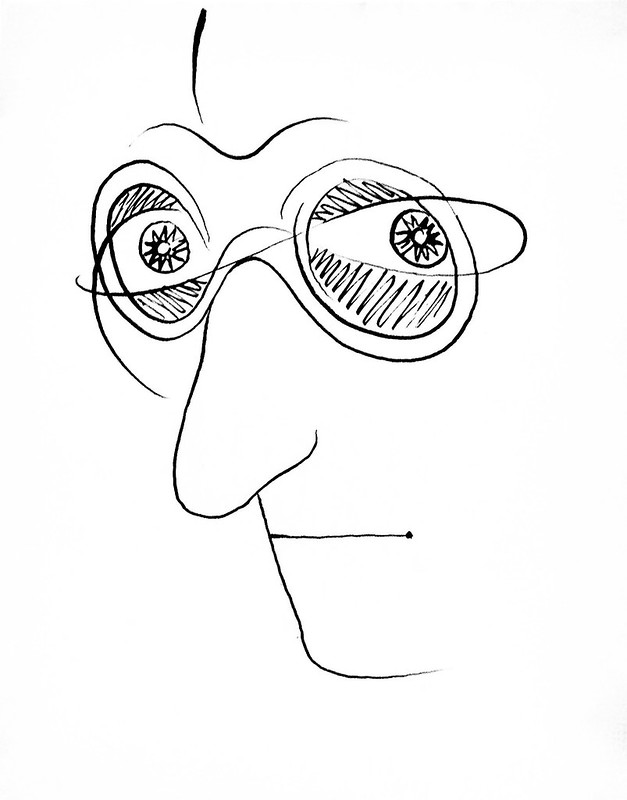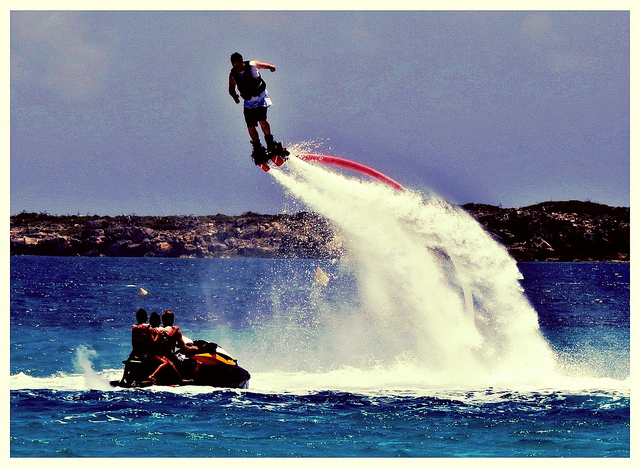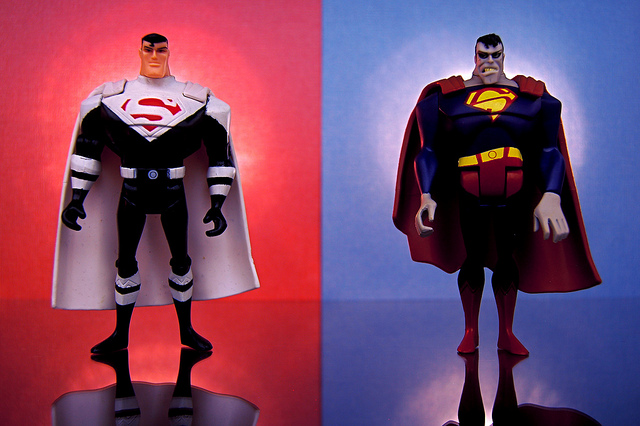Posts Tagged ‘less-with-far-less’
It’s time to turn something that isn’t into something that is.

It’s not possible until you demonstrate it.
It can’t be done until you show it being done.
It won’t work until you make it work.
It must be done using the standard process until you do it a much better way.
It’s required until you violate the requirement and everything is fine.
It’s needed until you show people how to do without.
It’s no one’s responsibility until you take responsibility and do it yourself.
It’s not fun until you have fun doing it.
It’s not sanctioned until you create something magical in an unsanctioned way.
It’s a crappy assignment until you transform it into a meaningful assignment.
It’s a lonely place until you help someone do their work better.
It’s a low-trust place until you trust someone.
It’s scary until you do it anyway.
So do it anyway.
Image credit — Tambako The Jaguar
The Difficulty of Goal Setting in Domains of High Uncertainty
 When you work in domains of high uncertainty, creating goals for the next year is exceptionally difficult.
When you work in domains of high uncertainty, creating goals for the next year is exceptionally difficult.
When you try to do something that hasn’t been done before, things may blow up instantly, things may work out after two years of hard work, or things may never work. So, how do you create the goal for that work? Do you give yourself one month to complete the work? And things haven’t worked out at the end of the month, do you stop the work or do you keep going? If it blows up instantly, but you think you know why, do you keep going? Do you extend the due date for the goal? At the start of the work, should the timeline have been set to one year instead of one month? And who decides that? And how do they decide?
When you have to create your goals for something that hasn’t been done before and the objectives of the work are defined by another team, yet that team hasn’t done the prework and cannot provide those objectives, what do you do? Do you create a goal for the other team to define the objectives? And what if you have no control over that team’s priorities and you don’t know when (or if) they’ll provide the needed information? What does a goal look like when you don’t know the objectives of the work nor do you know when (or if) you’ll get that information. Can you even create a goal for the work when you don’t know what that work is? And how do you estimate a completion date or the resource requirements (both the flavor and quantity) when you don’t know the objectives? What does that goal look like?
When you have to create your goals for a team of ten specialized people who each have unique skills, but you don’t know the objectives of the work, when that work can start, or when that work will finish, how do you cascade the team’s goals to each team members? What do their goals look like? Is the first goal to figure out the goal? How many goals does it take to fill up their year when you don’t know what the work is or how long it will take?
When working in domains of high uncertainty, the goals go like this: define the system as it is, define something you want to improve, try to improve it, and then do the next right thing. Unfortunately, that doesn’t fit well with the traditional process of setting yearly goals.
And your two questions should be: How do you decide what to improve? and How do you choose the next right thing?
Image credit — Rab Lawrence
How To Be Novel
 By definition, the approach that made you successful will become less successful over time and, eventually, will run out of gas. This fundamental is not about you or your approach, rather it’s about the nature of competition and evolution. There’s an energy that causes everything to change, grow and improve and your success attracts that energy. The environment changes, the people change, the law changes and companies come into existence that solve problems in better and more efficient ways. Left unchanged, every successful business endeavor (even yours) has a half-life.
By definition, the approach that made you successful will become less successful over time and, eventually, will run out of gas. This fundamental is not about you or your approach, rather it’s about the nature of competition and evolution. There’s an energy that causes everything to change, grow and improve and your success attracts that energy. The environment changes, the people change, the law changes and companies come into existence that solve problems in better and more efficient ways. Left unchanged, every successful business endeavor (even yours) has a half-life.
If you want to extend the life of your business endeavor, you’ve got to be novel.
By definition, if you want to grow, you’ve got to raise your game. You’ve got to do something different. You can’t change everything, because that’s inefficient and takes too long. So, you’ve got to figure out what you can reuse and what you’ve got to reinvent.
If you want to grow, you’ve got to be novel.
Being novel is necessary, but expensive. And risky. And scary. And that’s why you want to add just a pinch of novelty and reuse the rest. And that’s why you want to try new things in the smallest way possible. And that’s why you want to try things in a time-limited way. And that’s why you want to define what success looks like before you test your novelty.
Some questions and answers about being novel:
Is it easy to be novel? No. It’s scary as hell and takes great emotional strength.
Can anyone be novel? Yes. But you need a good reason or you’ll do what you did last time.
How can I tell if I’m being novel? If you’re not scared, you’re not being novel. If you know how it will turn out, you’re not being novel. If everyone agrees with you, you’re not being novel.
How do I know if I’m being novel in the right way? You cannot. Because it’s novel, it hasn’t been done before, and because it hasn’t been done before there’s no way to predict how it will go.
So, you’re saying I can’t predict the outcome of being novel? Yes.
If I can’t predict the outcome of being novel, why should I even try it? Because if you don’t, your business will go away.
Okay. That last one got my attention. So, how do I go about being novel? It depends.
That’s not a satisfying answer. Can you do better than that? Well, we could meet and talk for an hour. We’d start with understanding your situation as it is, how this current situation came to be, and talk through the constraints you see. Then, we’d talk about why you think things must change. I’d then go away for a couple of days and think about things. We’d then get back together and I’d share my perspective on how I see your situation. Because I’m not a subject matter expert in your field, I would not give you answers, but, rather, I’d share my perspective that you could use to inform your choice on how to be novel.
“Giraffe trying to catch a twig with her tongue” by Tambako the Jaguar is licensed under CC BY-ND 2.0
Continuous Improvement Is Dead
 Continuous Improvement – Do what you did last time, just three percent better, so none of your people can try new things.
Continuous Improvement – Do what you did last time, just three percent better, so none of your people can try new things.
Discontinuous Improvement – Make a radical step-change in performance at the expense of continuously improving it.
Continuous Improvement – Do what you did last time so you can say “no” to projects that are magical.
No-To-Yes – Make the product do something it cannot. That way you can sell a new value proposition to new customers and new markets. And you can threaten those that are clinging to your tired value proposition.
Continuous Improvement – Do what you did last time so no one will be threatened by meaningful change.
Less With Far Less – Reduce the goodness of today’s offering to free up design space and create an entirely new offering that provides 80% of the goodness at 20% of the price. That way, you can sell a whole new family of offerings to customers that cannot buy today’s offering.
Continuous Improvement – Do what you did last time so we can rest on our laurels.
Obsolete Your Best Work – Design and commercialize new offerings that purposefully make obsolete your most profitable offering. This requires level 5 courage.
And how do you do all this? Mobilize the Trust Network.
“fear — may 9 (day 9)” by theogeo is licensed under CC BY 2.0
What You Don’t Have
 If you have more features, I will beat you with fewer.
If you have more features, I will beat you with fewer.
If you have a broad product line, I will beat you with my singular product.
If your solution is big, mine will beat you with small.
If you sell across the globe, I will sell only in the most important market and beat you.
If you sell to many customers, I will provide a better service to your best customer and beat you.
If your new projects must generate $10 million per year, I will beat you with $1 million projects.
If you are slow, I will beat you with fast.
If you use short term thinking, I will beat you with long term thinking.
If you think in the long term, I will think in the short term and beat you.
If you sell a standardized product, I will beat you with customization.
If you are successful, I will beat you with my hunger.
If you try to do less, I will beat you with far less.
If you do what you did last time, I will beat you with novelty.
If you want to be big, I will be a small company and beat you.
I will beat you with what you don’t have.
Then, I will obsolete my best work with what I don’t have.
Your success creates inertia. Your competitors know what you’re good at and know you’ll do everything you can to maintain your trajectory. No changes, just more of what worked. And they will use your inertia. They will start small and sell to the lowest end of the market. Then they’ll grow that segment and go up-scale. You will think they are silly and dismiss them. And then they will take your best customers and beat you.
If you want to know how your competitors will beat you, think of your strength as a weakness. Here’s a thought experiment to explain. If your success is based on fast, turn speed into weakness and constrain out the speed. Declare that your new product must be slow. Then, create a growth plan based on slow. That growth plan is how your competitors will beat you.
Your growth won’t come from what you have, it will come from what you don’t have.
It’s time to create your anti-product.
The Power of Prototypes
 A prototype moves us from “That’s not possible.” to “Hey, watch this!”
A prototype moves us from “That’s not possible.” to “Hey, watch this!”
A prototype moves us from “We don’t do it that way.” to “Well, we do now.”
A prototype moves us from “That’s impossible.” to “As it turns out, it was only almost impossible.”
A prototype turns naysayers into enemies and profits.
A prototype moves us from an argument to a new product development project.
A prototype turns analysis-paralysis into progress.
A prototype turns a skeptical VP into a vicious advocate.
A prototype turns a pet project into top-line growth.
A prototype turns disbelievers into originators of the idea.
A prototype can turn a Digital Strategy into customer value.
A prototype can turn an uncomfortable Board of Directors meeting into a pizza party.
A prototype can save a CEO’s ass.
A prototype can be too early, but mostly they’re too late.
If the wheels fall off your first prototype, you’re doing it right.
If your prototype doesn’t dismantle the Status-Quo, you built the wrong prototype.
A good prototype violates your business model.
A prototype doesn’t care if you see it for what it is because it knows everyone else will.
A prototype turns “I don’t believe you.” into “You don’t have to.”
When you’re told “Don’t make that prototype.” you’re onto something.
A prototype eats not-invented-here for breakfast.
A prototype can overpower the staunchest critic, even the VP flavor.
A prototype moves us from “You don’t know what you’re talking about.” to “Oh, yes I do.”
If the wheels fall off your second prototype, keep going.
A prototype is objective evidence you’re trying to make a difference.
You can argue with a prototype, but you’ll lose.
If there’s a mismatch between the theory and the prototype, believe the prototype.
A prototype doesn’t have to do everything, but it must do one important thing for the first time.
A prototype must be real, but it doesn’t have to be really real.
If your prototype obsoletes your best product, congratulations.
A prototype turns political posturing into reluctant compliance and profits.
A prototype turns “What the hell are you talking about?” into “This.”
A good prototype bestows privilege on the prototyper.
A prototype can beat a CEO in an arm-wrestling match.
A prototype doesn’t care if you like it. It only cares about creating customer value.
If there’s an argument between a well-stated theory and a well-functioning prototype, it’s pretty clear which camp will refine their theory to line up with what they just saw with their own eyes.
A prototype knows it has every right to tell the critics to “Kiss my ass.” but it knows it doesn’t have to.
You can argue with a prototype, but shouldn’t.
A prototype changes thinking without asking for consent.
Image credit — Pedro Ribeiro Simões
The Five Hardships of Success
 Everything has a half-life, but we don’t behave that way. Especially when it comes to success. The thinking goes – if it was successful last time, it will be successful next time. So, do it again. And again. It’s an efficient strategy – the heavy resources to bring it to life have already been spent. And it’s predictable – the same customers, the same value proposition, the same supply base, the same distribution channel, and the same technology. And it’s dangerous.
Everything has a half-life, but we don’t behave that way. Especially when it comes to success. The thinking goes – if it was successful last time, it will be successful next time. So, do it again. And again. It’s an efficient strategy – the heavy resources to bring it to life have already been spent. And it’s predictable – the same customers, the same value proposition, the same supply base, the same distribution channel, and the same technology. And it’s dangerous.
Success is successful right up until it isn’t. It will go away. But it will take time. A successful product line won’t fall off the face of the earth overnight. It will deliver profits year-over-year and your company will come to expect them. And your company will get hooked on the lifestyle enabled by those profits. And because of the addiction, when they start to drop off the company will do whatever it takes to convince itself all is well. No need to change. If anything, it’s time to double-down on the successful formula.
Here’s a rule: When your successful recipe no longer brings success, it’s not time to double-down.
Success’s decline will be slow, so you have time. But creating a new recipe takes a long time, so it’s time to declare that the decline has already started. And it’s time to learn how to start work on the new recipe.
Hardship 1 – Allocate resources differently. The whole company wants to spend resources on the same old recipes, even when told not to. It’s time to create a funding stream that’s independent of the normal yearly planning cycle. Simply put, the people at the top have to reallocate a part of the operating budget to projects that will create the next successful platform.
Hardship 2 – Work differently. The company is used to polishing the old products and they don’t know how to create new ones. You need to hire someone who can partner with outside companies (likely startups), build internal teams with a healthy disrespect for previous success, create mechanisms to support those teams and teach them how to work in domains of high uncertainty.
Hardship 3 – See value differently. How do you provide value today? How will you provide value when you can’t do it that way? What is your business model? Are you sure that’s your business model? Which elements of your business model are immature? Are you sure? What is the next logical evolution of how you go about your business? Hire someone to help you answer those questions and create projects to bring the solutions to life.
Hardship 4 – Measure differently. When there’s no customer, no technology and no product, there’s no revenue. You’ve got to learn how to measure the value of the work (and the progress) with something other than revenue. Good luck with that.
Hardship 5 – Compensate differently. People that create something from nothing want different compensation than people that do continuous improvement. And you want to move quickly, violate the status quo, push through constraints and create whole new markets. Figure out the compensation schemes that give them what they want and helps them deliver what you want.
This work is hard, but it’s not impossible. But your company doesn’t have all the pieces to make it happen. Don’t be afraid to look outside your company for help and partnership.
Image credit — Insider Monkey
Improving What Is and Creating What Isn’t
There are two domains – what is and what isn’t. We’re most comfortable in what is and we don’t know much about what isn’t. Neither domain is best and you can’t have one without the other. Sometimes it’s best to swim in what is and other times it’s better to splash around in what isn’t. Though we want them, there are no hard and fast rules when to swim and when to splash.
Improvement lives in the domain of what is. If you’re running a Six Sigma project, a lean project or a continuous improvement program you’re knee deep in what is. Measure, analyze, improve, and control what is. Walk out to the production floor, count the machines, people and defects, measure the cycle time and eliminate the wasteful activities. Define the current state and continually (and incrementally) improve what is. Clear, unambiguous, measurable, analytical, rational.
The close cousins creativity and innovation live in the domain of what isn’t. They don’t see what is, they only see gaps, gulfs and gullies. They are drawn to the black hole of what’s missing. They define things in terms of difference. They care about the negative, not the image. They live in the Bizarro world where strength is weakness and far less is better than less. Unclear, ambiguous, intuitive, irrational.
What is – productivity, utilization, standard work. What isn’t – imagination, unstructured time, daydreaming. Predictable – what is. Unknowable – what isn’t.
In the world of what is, it’s best to hire for experience. What worked last time will work this time. The knowledge of the past is all powerful. In the world of what isn’t, it’s best to hire young people that know more than you do. They know the latest technology you’ve never heard of and they know its limitations.
Improving what is pays the bills while creating what isn’t fumbles to find the future. But when what is runs out of gas, what isn’t rides to the rescue and refuels. Neither domain is better, and neither can survive without the other.
The magic question – what’s the best way to allocate resources between the domains? The unsatisfying answer – it depends. And the sextant to navigate the dependencies – good judgement.
Image credit – JD Hancock
How To Create Eye-Watering Ideas
 With creativity, the leading thinking says the most important thing is to create many of ideas. When asked to generate many of ideas, the thinking goes, the team lets go of their inhibitions and good ideas slip through their mental filters. I’ve found that thinking misleading. I’ve found that creating many ideas results in many ideas, but that’s it. Before the session to create new ideas, you already had a pile of ideas you weren’t working on, and after the session is bigger, but not better.
With creativity, the leading thinking says the most important thing is to create many of ideas. When asked to generate many of ideas, the thinking goes, the team lets go of their inhibitions and good ideas slip through their mental filters. I’ve found that thinking misleading. I’ve found that creating many ideas results in many ideas, but that’s it. Before the session to create new ideas, you already had a pile of ideas you weren’t working on, and after the session is bigger, but not better.
What’s needed is several outlandish ideas that make your hair stand on end. The ideas should be so different that they cause you to chuckle to mask your discomfort. These ideas should be borderline unbelievable and just south of impossible. The ideas should have the possibility to change the game and tip your industry on its head.
The “many ideas” thinking has the right intent – to loosen the team’s thinking so they generate good ideas, but the approach is insufficient. To force the team to generated outlandish ideas they must be turned inside-out and put on the rack. Heretical ideas don’t come easily and drastic measures are needed. The team must be systematically stripped of the emotional constraints of their success using the Innovation Burst Event (IBE) method.
To prepare for the IBE, a reward-looking analysis is done to identify traditional lines of customer goodness (for example, miles per gallon for automobiles) and define how that goodness has changed over time (position it on the S-curve.) If the improvement has been flat, it’s time for a new line of customer goodness, and if the goodness is still steadily increasing, it’s time to create a new technology that will provide the next level of improvement. With this analysis the disposition of the system is defined and potentially fertile design space is identified. And within this design space, design challenges are created that force the team to exercise the highly fertile design space during the IBE.
Everything about the IBE is designed to strip the team of its old thinking. The IBE is held at an offsite location to change the scenery and eliminate reminders of traditional thinking and good food is served to help the team feel the day is special. But the big medicine is the design challenges. They are crafted to outlaw traditional thinking and push the team toward new thinking. The context is personal (not corporate) and the scale of the challenge is purposefully small to help the team let go of adjacent concerns. And, lastly, the team is given an unreasonably short time (five to ten minutes) to solve the problem and build a thinking prototype (a prototype that stands for an idea, not at functional prototype.)
Everything about the IBE helps the team let go of their emotional constraints and emit eye-watering solutions. The design challenges force them to solve problems in a new design space in a way and does not give them a chance to limit their thinking in any way. The unrealistic time limit is all-powerful.
Four design challenges is about all team can handle in the one-day IBE. With the IBE they come up with magical ideas clustered around four new areas, new areas that have the potential to flip your industry on its head. In one day, a team can define market-changing ideas that obsolete your best products and even your business model. Not bad for one day.
It may be popular wisdom that it’s best to create many new ideas, but it’s not the best way. And it contradicts popular belief that a team can create three or four game-changing ideas in a single day. But the IBEs work as advertised.
Don’t waste time creating a pile of ideas. Spend the time to identify fertile design space and hold a one-day IBE to come up with ideas that will create your future.
Image credit – moonjazz
A most powerful practice – Try It.
 The first question is usually – What’s the best practice? And the second question is – Why aren’t you using it? In the done-it-before domain this makes sense. Best practices are best when inputs are tightly controlled, process steps are narrowly defined, and the desired output is known and can be formally defined.
The first question is usually – What’s the best practice? And the second question is – Why aren’t you using it? In the done-it-before domain this makes sense. Best practices are best when inputs are tightly controlled, process steps are narrowly defined, and the desired output is known and can be formally defined.
Industry loves best practice because they are so productive. Like the printing press, best practices are highly effective when it’s time to print the same pages over and over. It worked here, so do it there. And there. And there. Use the same typeface and crank it out – page by page. It’s like printing money.
Best practices are best utilized in the manufacturing domain, until they’re not. Which best practice should be used? Can it be used as-is, or must it change? And, if a best practice is changed, which version is best? Even in the tightly controlled domain of manufacturing, it’s tricky to effectively use best practices. (Maybe what’s needed is a best practice for using best practices.)
Best practices can be good when there’s strong commonality with previous work, but when the work is purposefully different (think creativity and innovation), all bets are off. But that doesn’t stop the powerful pull of productivity from jamming round best practices into square holes. In the domain of different, everything’s different – the line of customer goodness, the underpinning technology and the processes to make it, sell it, and service it. By definition, the shape of a best practice does not fit work that has yet to be done for the first time.
What’s needed is a flexible practice that can handle the variability, volatility, and uncertainty of creativity/innovation. My favorite is called – Try It. It’s a simple process (just one step), but it’s a good one. The hard part is deciding what to try. Here are some ways to decide.
No-to-yes. Define the range of inputs for the existing products and try something outside those limits.
Less-with-far-less. Reduce the performance (yes, less performance) of the very thing that makes your product successful and try adolescent technologies with a radically lower cost structures. When successful, sell to new customers.
Lines of customer goodness. Define the primary line of customer goodness of your most successful product and try things that advance different lines. When you succeed, change all your marketing documents and sales tools, reeducate your sales force, and sell the new value to new customers.
Compete with no one. Define a fundamental constraint that blocks all products in your industry, try new ideas that compromise everything sacred to free up novel design space and break the constraint. Then, sell new products into the new market you just created.
IBE (Innovation Burst Event). Everything starts with a business objective.
There is no best way to implement the Try It process, other than, of course, to try it.
Image credit — Alland Dharmawan.
The Lonely Chief Innovation Officer
 Chief Innovation Officer is a glorious title, and seems like the best job imaginable. Just imagine – every-day-all-day it’s: think good thoughts, imagine the future, and bring new things to life. Sounds wonderful, but more than anything, it’s a lonely slog.
Chief Innovation Officer is a glorious title, and seems like the best job imaginable. Just imagine – every-day-all-day it’s: think good thoughts, imagine the future, and bring new things to life. Sounds wonderful, but more than anything, it’s a lonely slog.
In theory it’s a great idea – help the company realize (and acknowledge) what it’s doing wrong (and has been for a long time now), take resources from powerful business units and move them to a fledgling business units that don’t yet sell anything, and do it without creating conflict. Sounds fun, doesn’t it?
Though there are several common problems with the role of Chief Innovation Officer (CIO), the most significant structural issue, by far, is the CIO has no direct control over how resources are allocated. Innovation creates products, services and business models that are novel, useful and successful. That means innovation starts with ideas and ends with commercialized products and services. And no getting around it, this work requires resources. The CIO is charged with making innovation come to be, yet authority to allocate resources is withheld. If you’re thinking about hiring a Chief Innovation Officer, here’s a rule to live by:
If resources are not moved to projects that generate novel ideas, convert those ideas into crazy prototypes and then into magical products that sell like hotcakes, even the best Chief Innovation Officer will be fired within two years.
Structurally, I think it’s best if the powerful business units (who control the resources) are charged with innovation and the CIO is charged with helping them. The CIO helps the business units create a forward-looking mindset, helps bring new thinking into the old equation, and provides subject matter expertise from outside the company. While this addresses the main structural issue, it does not address the loneliness.
The CIO’s view of what worked is diametrically opposed to those that made it happen. Where the business units want to do more of what worked, the CIO wants to dismantle the engine of success. Where the engineers that designed the last product want to do wring out more goodness out of the aging hulk that is your best product, the CIO wants to obsolete it. Where the business units see the tried-and-true business model as the recipe for success, the CIO sees it as a tired old cowpath leading to the same old dried up watering hole. If this sounds lonely, it’s because it is.
To combat this fundamental loneliness, the CIO needs to become part of a small group of trusted CIOs from non-competing companies. (NDAs required, of course.) The group provides its members much needed perspective, understanding and support. At the first meeting the CIO is comforted by the fact that loneliness is just part of the equation and, going forward, no longer takes it personally. Here are some example deliverables for the group.
Identify the person who can allocate resources and put together a plan to help that person have a big problem (no incentive compensation?) if results from the innovation work are not realized.
Make a list of the active, staffed technology projects and categorize them as: improving what already exists, no-to-yes (make a product/service do something it cannot), or yes-to-no (eliminate functionality to radically reduce the cost signature and create new markets).
For the active, staffed projects, define the market-customer-partner assumptions (market segment, sales volume, price, cost, distribution and sales models) and create a plan to validate (or invalidate) them.
To the person with the resources and the problem if the innovation work fizzles, present the portfolio of the active, staffed projects and its validated roll-up of net profit, and ask if portfolio meets the growth objectives for the company. If yes, help the business execute the projects and launch the products/services. If no, put a plan together to run Innovation Burst Events (IBEs) to come up with more creative ideas that will close the gap.
The burning question is – How to go about creating a CIO group from scratch? For that, you need to find the right impresario that can pull together a seemingly disparate group of highly talented CIOs, help them forge a trusting relationship and bring them the new thinking they need.
Finding someone like that may be the toughest thing of all.
Image credit – Giant Humanitarian Robot.

 Mike Shipulski
Mike Shipulski